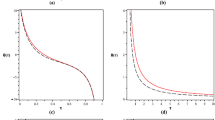Abstract
When dealing with a spacetime, one usually searches for singularities, black holes, white holes and wormholes due to their importance to the motion of particles. There is a family of solution of the Brans–Dicke vacuum equations that has not been fully studied from this perspective. In this paper, I study some properties of this family and find the complete set of solutions that avoids singularity at the point where the metric diverges or degenerates. The possible changes in the metric signature when passing through this point is analyzed. In addition, I also study the radial geodesics and obtain the solutions of some particular cases.




Similar content being viewed by others
Notes
It is defined as
 .
.For the case \(r<r_0\) and m either an even integer or an irreducible fraction of the type even/odd, the situation is a little bit more involved because setting \(\dot{R}_i=0\) no longer means releasing the particle from rest at \(r_i\) (r is a time coordinate in this case). I shall not pursue this issue here.
Notice that the expression \(1-n-(2-n)\frac{r_0}{2r}\) can be recast as \((1-n)(1-r_c/r)\), which clearly changes its sign.
Using the plus sign in Eq. (43) one can show that the particle can come back to the universe \(r\in (r_m,\infty )\) if an appropriate initial velocity is given to the particle when it is at the other universe.
References
Brans, C., Dicke, R.H.: Phys. Rev. 124, 925 (1961)
Faraoni, V., Capozziello, S.: Beyond Einstein Gravity. Springer Science+Business Media, Berlin (2011)
Will, C.: Space Sci. Rev. 148, 3 (2009)
Banerjee, N., Pavón, D.: Phys. Rev. D 63, 043504 (2001)
Sen, A.A., Sen, S., Sethi, S.: Phys. Rev. D 63, 107501 (2001)
La, D., Steinhardt, P.J.: Phys. Rev. Lett. 62, 376 (1989)
Campanelli, M., Lousto, C.: Int. J. Mod. Phys. D 02, 451 (1993)
Bhadra, A., Sarkar, K.: Gen. Relativ. Gravit. 37, 2189 (2005)
Vanzo, L., Zerbini, S., Faraoni, V.: Phys. Rev. D 86, 084031 (2012)
Formiga, J.B.: Phys. Rev. D 83, 087502 (2011)
Formiga, J.B., Almeida, T.S.: Int. J. Mod. Phys. D 23, 1450086 (2014). doi:10.1142/S0218271814500862
Hochberg, D., Visser, M.: Phys. Rev. D 56, 4745 (1997)
Author information
Authors and Affiliations
Corresponding author
Rights and permissions
About this article
Cite this article
Formiga, J.B. Analyzing the radial geodesics of the Campanelli–Lousto solutions. Gen Relativ Gravit 47, 146 (2015). https://doi.org/10.1007/s10714-015-1967-4
Received:
Accepted:
Published:
DOI: https://doi.org/10.1007/s10714-015-1967-4





 .
.